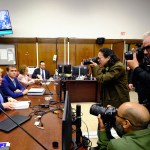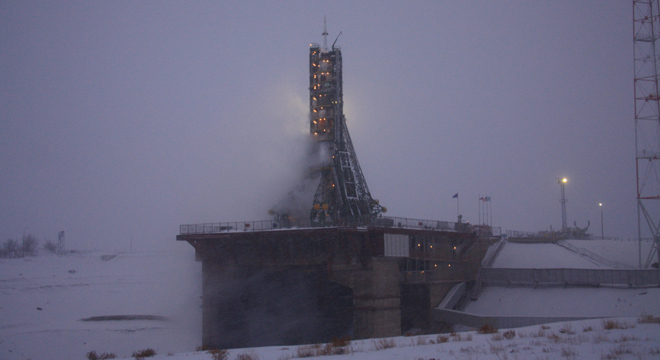A Russian Soyuz rocket successfully launched from Kazakhstan late Sunday, carrying three replacement crew members to the International Space Station, including two Russian cosmonauts and a NASA astronaut.
The launch was a critical one for both NASA and the Russian space agency, Roscosmos, as it was necessary to replace the space station’s current crew of three (one NASA astronaut, one Russian cosmonaut and one Japanese astronaut), who are scheduled to return to Earth aboard a separate Soyuz on November 21.
Watch the successful blast-off from the snow-covered Baikonur Cosmodrome in the following video:
The Soyuz TMA-22 crew capsule is scheduled to dock with the with space station on Tuesday at 11:33 pm ET and NASA will host a live video stream of the event on its NASA TV website. A formal handoff of the station’s command duties, from current commander NASA astronaut Mike Fossum to his NASA colleague Dan Burbank, is scheduled for November 20, kicking-off the 30th expedition to the International Space Station. Burbank’s crew is due back to earth in March 2012.
“17 more hours and we’ll be in orbit chasing down ISS,” Burbank tweeted prior to the launch on Sunday. “Can’t wait to see Mike, Sergei & Satoshi!”
There was some question in the three months prior to Sunday’s launch whether or not it would take place in time to avoid leaving the space station vacant, piloted from the ground, for a period of time.
Sunday’s launch was originally scheduled for September, but was delayed as the Soyuz program came under technical review following the August crash of an unmanned Soyuz rocket carrying a Progress cargo module.
Although Russian engineers eventually traced the cause of the crash back to a freak manufacturing defect in the rocket’s fuel injector equipment, the incident — coupled with the recent failure of an unrelated, unmanned Russian probe, the Phobos Grunt — have sowed understandable concern about Russia’s human spacefaring abilities and the country’s aims to usher in an “age of reliability” in human spaceflight following the retirement of the NASA Space Shuttle program, that final mission of which concluded in July.
Nonetheless, NASA expressed confidence leading up to the launch, saying that Russian engineers had accomplished “an amazing amount of work” to identify the flaw that lead to the August Soyuz crash, and that a return to safe, reliable flight was assured.
Another Soyuz crew capsule, carrying another three astronauts (One American, one Russian and one of the European Space Agency) is due for the International Space Station on December 21, rounding out the 6-man crew of Expedition 30.
Expedition 30 is also notable because it is supposed to see the first-ever docking of an unmanned commercial spacecraft with the space station: SpaceX’s Dragon capsule is due to launch from Cape Canaveral, Florida between January 7, 2010 and January 12, 2012 according to Spaceflight Now, but the launch window is challenging due to seasonal conditions and could be bumped to February, the blog reports.
Here’s a simulation video fo a Dragon cargo mission to the ISS from Space X.
The U.S. is paying Russia $51 million per each seat for a NASA astronaut on a Soyuz capsule this year, the AFP reported. The cost climbs to $55.9 million in 2013 and up to $62.7 million per seat in 2014 and 2015, according to SPACE.com.
That’s still far cheaper than the cost of a seat on the Space Shuttle, an estimated $229 million, averaging out the cost of the entire program.
By comparison, SpaceX says that its Dragon capsule will eventually be able to carry 7 astronauts to the space station at a cost of $20 million a seat, but has not set a date for when it could begin crew missions. The company says it is waiting on NASA to give it the green light.









